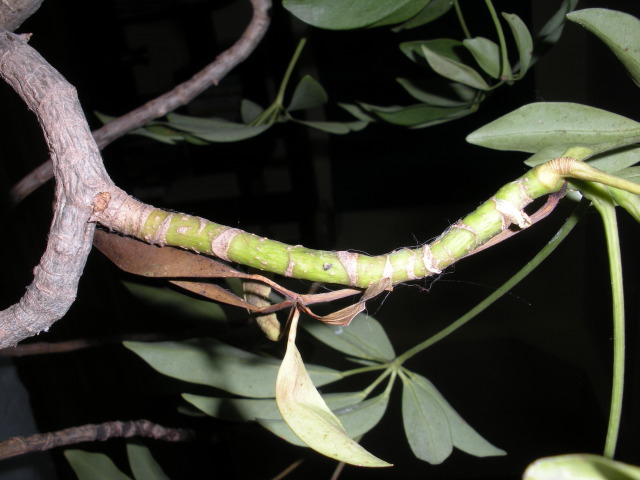QuestionQUESTION: Hi, Nick
I saw your response to someone in Fla. about frost damage to a shefflera. I live in Nebraska, and we recently had temps reaching -24. Our schefflera was in our sun room, and got too cold. Some leaves turned black, and the pot was very cold. We moved it in, and pruned dead or damaged leaves and branches, leaving foliage that looked healthy. This green foliage is slowly folding up and drying, as if from lack of water. The soil is damp, not wet. Yesterday, I pulled the plant out of the pot to look at the roots. There was some webbing around the edge of the pot (we keep it outside during the summer). I expected to see black, dead, rotting roots, but they looked light brown, firm and supple. I saw what looked like a carpenter ant living in the root soil.
When I checked the trunk, it felt as if there was perhaps a millimeter of give to the bark before it hit solid material underneath. The ends of the living branches are firm, with no give at all. There is also some green, living material on these branches, so obviously did not freeze. My questions are : did the trunk freeze and is therefore not sending nutrients to the branches (hard to believe since the leaves are still alive), is there some damage sustained from a parasite that is killing the trunk from underneath, should I propagate from the parts that are still alive, will it come back from the roots. This plant is over 30 years old and has much sentimental value for me. Thank you.
ANSWER: Jim, that soil needs to be changed out, I am not sure of the Ant you found, but it appears that the cold, damp existing soil is compacted and compromising the root system of the plant; from your statement, the roots appear sound, but they need to begin functioning properly so nutrients can be taken up into the crown and the plant can begin repairing itself from the cold stress. Sheffs are very durable plants, and it takes a lot to actually do one in, so I think it should come back for you , but it will take time and patience. Repot it with a good grade "Potting" soil (not Top soil) and place a couple of inches of gravel along the bottom of the pot to catch excess water, thus keeping the roots from sitting in saturated soil, like they are now. Put the container in a warm area with direct light if possible, like near a window. Once you see new growth commence, get in the habit of misting it frequently, this will deter Spider Mites, which can be the bane of a houseplant, because of the dry air. You can take a tip cutting and propagate it (to hedge your bet, and keep the heirloom going...), but I think the original will be fine. Nick
---------- FOLLOW-UP ----------
QUESTION: Thank you very much. I am happy that there is room for optimism. I am on the way out the door to get some potting soil. I guess the thing that still worries me is the fact that the bark of the trunk and main branches has some "give". I am wondering if the trunk and main branches have already been compromised, and have the ability to transport what the roots take in. Is there information out there on the best way to propagate a cutting? I've heard they are hard to root and the best way is air layering. Conversely, I have heard that it is no problem rooting a cutting. Thanks again for your time and prompt response.
ANSWER: Jim , you need about a 6 inch , fresh tip cutting, dip it in a rooting hormone (Home Depot or Lowes has them...) and place it in a small container, moisten the soil and put a baggi over it to keep the soil and cutting from drying out too fast; put the cutting in an area with indirect light and then watch and wait, it takes a couple of weeks for roots to develop, then you can transplant, once you see crown growth. The adult should be fine though, even if the crown looks real bad, its the roots that will tell the tale of the tape. Scratch the bark and make certain that the Cambium layer is showing green, anywhere along the trunk. Nick
---------- FOLLOW-UP ----------
 schefflera
schefflera
QUESTION: Thank you for your response - your suggestion to scratch the bark was an excellent one.
As I suspected, the main trunk and main branches are black under the bark - obviously the main woody parts froze, and are unable to send nutrients from the roots to the extremities.
We are thinking of taking as many cuttings from the green extremities as possible. My question now is: should I cut away the dead trunk - this would mean practically cutting to the soil level. Secondly, should I still repot? Is there any chance of new growth coming from the roots? I am nervous about doing the cuttings - my experience is that they rot before they root.
Answer...No Jim, don't be in a rush to excise the dead tissue, you need new growth to appear so that you have a clearer picture of just what needs to be removed; the cuttings shouldn't rot if the soil is kept at the right level of moisture content, and that is damp, but not wet, and use vermiculite not soil for the process (my bad, in saying soil earlier...). The image you supplied tells me that the crown is getting nutrients, otherwise there would be no live tissue at all. Take your cuttings, but leave green tissue on the parent plant, then repot as I said earlier, and put it in a shadier area and keep it "properly" irrigated, not wet. Nick






